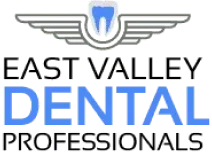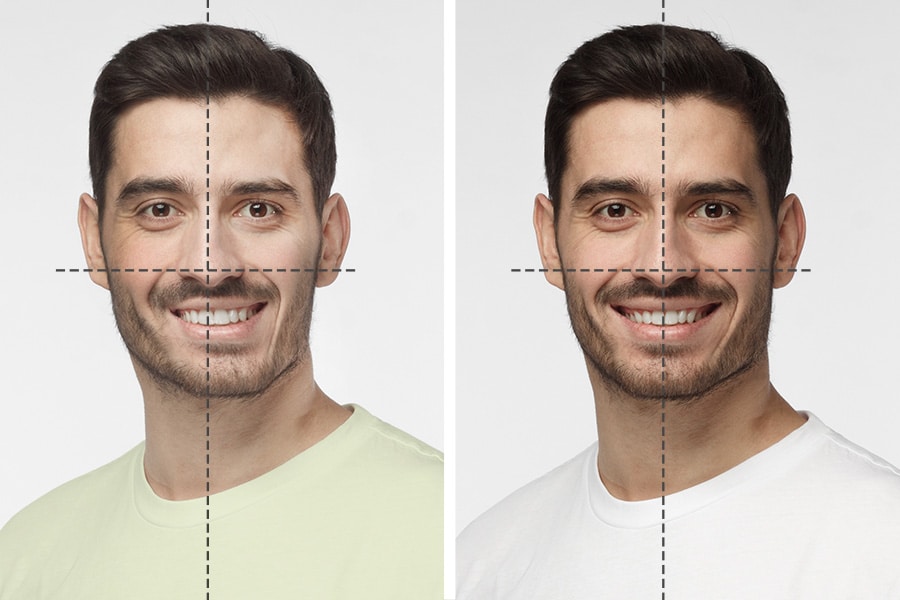Correcting facial asymmetry doesn’t always require surgery and a long recovery. For example, cosmetic dentistry is an area that you can help contribute to a symmetrical face.
Dental treatments such as veneers, ceramic braces, lingual braces, and Invisalign are non-invasive options you can choose from. While nobody has perfect symmetry, some types of asymmetry can make your life harder, and not only aesthetically.
When it comes to the jaw, facial symmetry is quite important because it can affect the way you eat and speak. Not to mention, it can even lead to pain.
After we understand the causes, we will learn how to fix an asymmetrical face.
What causes an asymmetrical face?
There are two types of facial asymmetry: pathological and developmental. It can be caused either by genetics or it can develop due to teeth misalignment, uneven muscles, accidents, and infections.
When it comes to genetics, hemifacial microsomia (HFM) is one of the most common conditions that cause severe asymmetry. Fortunately, the gene behind this condition has been recently discovered.
What are the symptoms of an asymmetrical face?
Along with facial asymmetry, there are also some symptoms you may face, such as:
Overbite
While almost all people have varying levels of overbite, you could have a noticeable difference of the top teeth over the bottom. We tell our patients to look for sunken cheeks as one asymmetrical facial symptom.
Underbite
The opposite of an overbite is when the bottom teeth rest below the top teeth. This condition makes your chin appear more prominent and is a form of malocclusion.
Openbite
You may be ashamed of an openbite where the top and bottom teeth don’t come together at all. As a result, the jaw structure morphs as the lips overstretch themselves to cover the teeth.
Crossbite
Shifting the jaw with preference to one side over the other can misalign your face. We’ve seen this occur with patients that have 1 or several bottom teeth that cover some of the top teeth.
You can also experience general pain in your jaw and mouth that may indicate an asymmetrical face like:
- An impact of the movements of the head
- Swelling
- Pus
- Pain
- Fever
- Difficulty chewing
Symptoms such as pus and fever require emergency care and shouldn’t be ignored even if the facial asymmetry is minor. In some cases, the asymmetry doesn’t impact the entire face but it can still lead to complications and pain.
TMD & Facial Asymmetry
A temporomandibular disorder (TMD) is usually the cause of jaw asymmetry and it comes with an array of symptoms depending on how severe the condition is.
You may experience:
- Headaches and pain in the jaw area
- Stiffness in the back of your neck
- Limited movements when chewing
- Popping sounds when opening and closing your mouth
The most confusing part about this condition is that the symptoms come and go. If you’re suffering from a crooked or uneven jaw, TMJ may be the cause. Over time, it can lead to swelling and inflammation as well.
This condition is usually kept under control by using anti-inflammatories and painkillers to prevent any swelling or pain that comes with it.
Overall, TMD requires a dental professional to look at your jaw and offer expert treatment.
What dental treatments are available?
Now we need to know how to fix an asymmetrical face. Depending on the diagnosis, there are several options available, from an orthodontic treatment to a surgical treatment.
Braces
Braces not only straighten your teeth but also realign your facial structure. You’ll find in some cases that the upper and lower jaws do not grow at the same rate, creating uneven symmetry.
Although this dental solution can take up to 18 to 24 months, they produce a brand new smile that can last you a lifetime.
Invisalign
The new alternative to braces is Invisalign, which is a clear plastic aligner that brings your teeth back together. This insertable piece removes gaps, misaligned teeth, and faulty facial structures.
You can feel proud to grin in public without embarrassment since most people can’t even notice Invisalign in teeth.
Veneers
Finally, most dental experts offer veneers made from porcelain or resin materials and cover your front teeth, looking no different from normal teeth. Keep in mind that veneers only hide your crooked teeth: they do not realign your jaw or facial structure.
You may not have the budget for braces or Invisalign, so this dental solution may be a better option. We recommend speaking to a dental professional first to ensure this is the best option for your oral health and teeth aesthetic.
What steps should I take to fix an asymmetrical face?
If you think you have an asymmetrical face, the best way to find out the cause and solution is by visiting your dentist.
The first step that will be taken in a dentist’s office is finding out if you need immediate treatment. In some cases, infections cause swelling and the need for treatment is urgent.
If you don’t suffer from any infections, an X-ray will be used to examine the bones of your entire face.
Asymmetrical Face FAQ
What level of treatment do asymmetrical faces need?
In the past, even milder cases were fixed with surgical treatments alone. In the present, dentists have developed ways to fix facial asymmetry with braces, leaving surgery for more serious cases only.
When braces alone won’t fix the issue, surgical treatment is needed. Also, when dealing with uneven muscles or bone structure issues, plastic surgery or jaw surgery might be needed as well.
What if my child has an asymmetrical face?
If a child suffers from bone structure issues or uneven muscles, they may not have success with regular treatments.
Surgery is a possibility, but an expert dentist would delay it because in the developmental phase the uneven muscles might grow uneven despite surgery.
After the child stops developing, these issues can be fixed via surgery. In this case, your specialist will ask for your full medical records to prevent any complications from arising during the surgery.
Conclusion
If you suspect that you’re suffering from a case of facial asymmetry, don’t hesitate to ask a specialist about your options. In most cases, facial asymmetry can be fixed by non-invasive treatments, and only severe cases require jaw surgery.
However, you must keep in mind that severe cases don’t just affect the aesthetics of your face but also the functionality of your lower skull. In time, this may lead to functional issues, swelling, inflammation, and pain.
If you have any questions about dental treatments for facial asymmetry and how you can take action, don’t hesitate to contact us.

